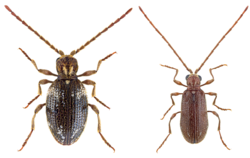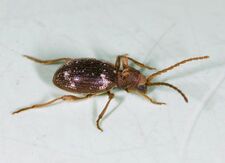Biology:Ptinus fur
| Ptinus fur | |
|---|---|

| |
| Scientific classification | |
| Kingdom: | |
| Phylum: | |
| Class: | |
| Order: | |
| Family: | |
| Genus: | |
| Subgenus: | Ptinus (Ptinus)
|
| Species: | P. fur
|
| Binomial name | |
| Ptinus fur | |
| Synonyms | |
| |
Ptinus fur, the white marked spider beetle, is a species of spider beetle in the genus Ptinus (family Ptinidae), with a nearly cosmopolitan distribution.[1]
Description
Adults are morphologically similar to other spider beetle species, notably the hairy spider beetle (Ptinus villiger).[2] It is red-brown with yellow hairs, and measures 2.0–4.3 millimetres (0.08–0.17 in) in length. The prothorax is densely covered with pale hairs, while the elytra bear some patches of white scales.[1]
Distribution and Habitat
It is a pest of stored foods,[2] with a worldwide distribution, where it may be identified by leaving webbed, granular materials on the stored products.[2] Ptinus fur adults feed on dried and decaying animal and vegetable material.[2][3] It has also been identified as a pest in museums, damaging stored collections.[3]
It has been found in the nests of birds, notably the Sand Martin.[4]
Life cycle
The optimum temperature for rapid development of Ptinus fur is about 23 °C, at which temperature it completes its development in a mean period of 132 days.[5] Larvae of P. fur normally moult three times at 23°Cm but some have an extra moult.[5]
Well-defined diapause as mature larvae in cocoons occurs at low temperatures in some individuals of Ptinus fur: at 23 °C this lasts about 220 days after normal larvae have pupated; at 20 °C the period lasts about 280 days.[5]
Adult beetles live for several months.[5]
References
- ↑ 1.0 1.1 "Insect Fact Sheet 12. Spider Beetles & Biscuit Beetles". Salford City Council. http://www.salford.gov.uk/d/insect13spiderbeetle.pdf. Retrieved November 5, 2010.
- ↑ 2.0 2.1 2.2 2.3 "Whitemarked spider beetle Ptinus fur (L.)". Canada Grain Commission, Government of Canada. 2013. https://www.grainscanada.gc.ca/storage-entrepose/sip-irs/wsb-pb-eng.htm. Retrieved 2017-01-22.
- ↑ 3.0 3.1 Chinery, M. 2012. Insects of Britain and Western Europe (Domino Guides), Revised Edition. London: Bloomsbury. pp 274.
- ↑ Kirstofik, J.; Sustek, Z. (1994). "Arthropods in the nests of the Sand Martin (Riparia riparia Linnaeus, 1758) in South Slovakia". Biologia Bratislava. https://www.researchgate.net/publication/269093244.
- ↑ 5.0 5.1 5.2 5.3 Howe, R. W.; Burges, H. D. (1951). "Studies on Beetles of the Family Ptinidae.* VI.—The Biology of Ptinus fur (L.) and P. sexpunctatus Panzer". Bulletin of Entomological Research 42 (3): 499. doi:10.1017/S0007485300028893.
External links
Wikidata ☰ Q1310828 entry
 |


